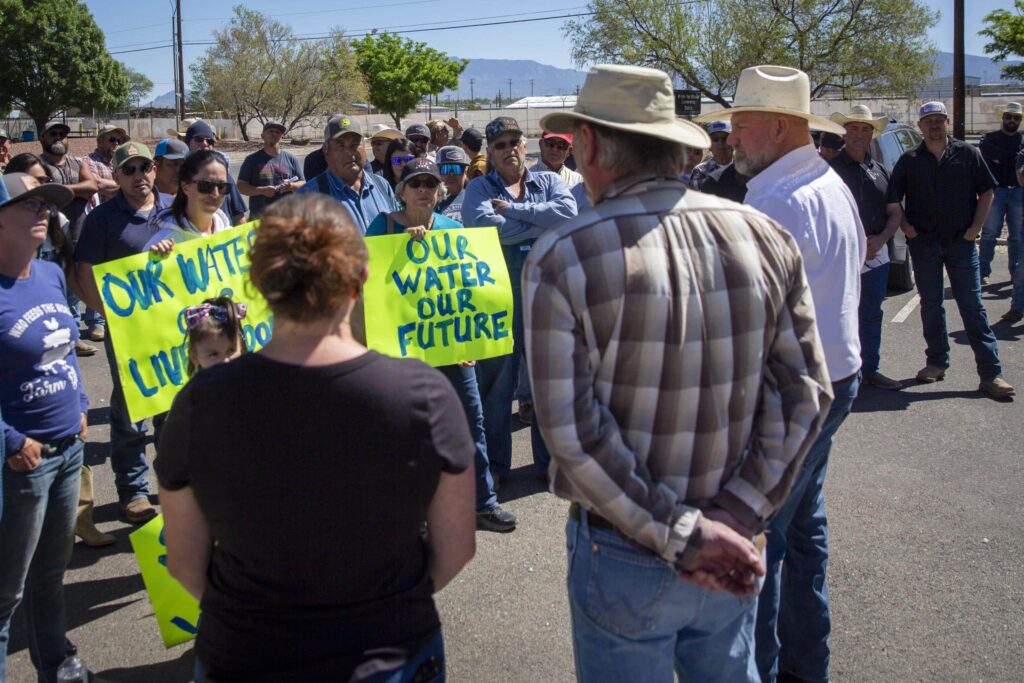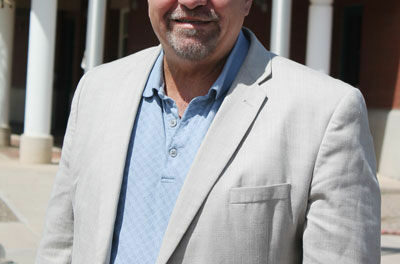After protesting in the parking lot, farmers packed the board room as the board of supervisors for the Middle Rio Grande Conservancy District decided whether to raise property taxes by 1 mill throughout the district.
During Monday’s meeting, many farmers didn’t address the mill levy directly but did criticize the district’s lack of infrastructure maintenance, which is what the property tax increase will address, according to MRGCD CEO and Chief Engineer Jason Casuga.
The levy was approved by the board on a 5-0 vote and is expected to generate about $4.3 million a year. The funding will be bound to infrastructure improvements district wide, including construction projects, matching funds for infrastructure grants and loan repayments.
“The resolution approved by the board binds this mill forever, like a bond program, to infrastructure projects. The public will see on our books a separate account for the capital infrastructure improvement fund, separate from the general, operational fund,” Casuga said. “We are building a capital infrastructure program and this is the funding.”

Middle Rio Grande Conservancy District staff members talk with farmers from throughout the district, including many from Valencia County, who protested at the MRGCD office in Albuquerque on Monday. Those protesting were critical of the district’s late water delivery and lack of infrastructure repairs district wide. The MRGCD board of supervisors later in the day voted 5-0 in favor of a tax increase that will generate $4.3 million a year for infrastructure projects. (Jon Austria/Albuquerque Journal)
After an assessment of district infrastructure needs, staff generated a list of projects totaling $680 million, with 19 priority projects totaling $175 million. Some of those priority projects include a feeder 3 pump station in Valencia County, which would provide irrigation during drought years, Casuga said, as well as the Isleta Damn gate automation, the Corrales Siphon, Socorro Main Canal channel lining and Belen Highline realignment.
The board of supervisors, as per state law, can only consider raising the district’s mill levy rate every five years, Casuga said, but nothing prevents it from lowering the rate at any time. All property owners within the district boundaries pay the district mill rate, not just irrigators.
The district’s mill rate has been unchanged since 1998, when the board lowered property taxes to the current amounts. The new rates of 6.0693 for residential properties and 7.334 for nonresidential properties will be on tax bills sent out in November.
According to calculations provided by the district, property owners will see an increase of $30 to $100 per year for properties valued at $100,000 to $300,000. Tax exemptions, such as agricultural use, will be applied and impact the actual increase.
The mill levy resolution also froze the district’s water service charge at $43.82 per acre for the upcoming 2023-24 fiscal year, but it will be reviewed prior to the submission of the 2024-25 budget.
Troy Richardson, a Valencia County commissioner who manages 650 acres in Belen and owns a business directly connected to farming, told the MRGCD board of supervisors there has been no regular maintenance and dredging of ditches since 2015.
Without dredging, ditches will fill with debris, be less efficient and continue to breach, the commissioner told the board.
“Removal of vegetation is lacking. Damaged and leaking checks and turnouts have been brought to the attention of the district and nothing has been done,” Richardson said. “There are delays during irrigation season that should have been addressed during the off season. With proper maintenance, water can be delivered quickly and efficiently to farmers. In years of availability, we should be able to easily access water.”
Two irrigators spoke in favor of the mill levy, one of which is a district employee.
Socorro County resident Guy McElvain said he understood what the dilapidated infrastructure means to the MRGCD.
“If you don’t have infrastructure, you don’t have an irrigation district,” McElvain said. “What you have is a large bureaucracy running out sticking a finger in the dike. These infrastructure projects are trying to increase efficiency throughout the district.”
Rusty Swint, the district’s equipment and transportation manager, said the district has seen “many catastrophic failures.” Just looking at equipment, the district has 159 out of 333 assets in need of replacement due to age, mileage and repair costs, he said.
“Trying to order a three-quarter ton truck is $20,000 higher, if you can get it. (Motor oil) has increased 115 to 137 percent. It’s 15 to 20 percent on parts,” Swint said, who is also an irrigator in Valencia County. “I’ve been a first-hand witness to the aged sites that need to be repaired.”
Before the board voted, Richardson said while he did understand the need to spend money on infrastructure and appreciated the mill levy would be specific to that need, “looking at the budget presentation I noticed you didn’t look for money anywhere but in my pocket. I would like to see you make spending cuts somewhere else.”
Many irrigators who took part in a tractor convoy to the MRGCD’s Albuquerque offices Monday morning returned to the Duke City that afternoon to voice their concerns and criticisms about the district’s ability to deliver much needed water.
Valencia County farmer Mark Garcia told the board while they looked at a lot of data during the meeting, he wanted to “get a little micro with you.” He told the board about waiting on the ditchbank for water, scrolling through Craig’s List only to find a friend’s tractor for sale.
Garcia said the fellow farmer told him he just couldn’t afford to farm anymore. Water delays from the district had just put him too far behind to bring in a profit.
“We have so much invested in our property. It’s disheartening when you see people doing that,” Garcia said. “You can talk data and we might not know data but we know the bottom dollar. We can’t make payments, are spending so much money. He got water eventually but the damage was done. You can’t make water run up hill. You can’t make plants grow faster and then you have to sell. You see all this water in the river and it’s disheartening.”
During the meeting, Matt Martinez, the district’s water distribution manager, said the irrigation season began with some miscommunications in which some district staff members were under the impression water delivery was to be done on a strict 21-day rotation.
“We did not teach them that. We teach supply, demand and efficiency, with delivery to expand and contract with water supply,” Martinez told the board. “I acknowledge we had a slow start in some areas. We’ve met with our system operators and supervisors to clarify expectations and communications.”
Richardson pointed out there are 250,000 agricultural employees throughout New Mexico, noting the industry creates $40 billion in economic activity in the state.
“There are thousands of family-owned farms, consumers and small businesses that rely on agriculture,” he said. “Producers in the Rio Grande Valley rely on timely delivery of irrigation water. Because it was delayed, many farmers lost crops. With revenue lost year after year, farmers are no longer able to maintain.”
Julia M. Dendinger began working at the VCNB in 2006. She covers Valencia County government, Belen Consolidated Schools and the village of Bosque Farms. She is a member of the Society of Professional Journalists Rio Grande chapter’s board of directors.

















